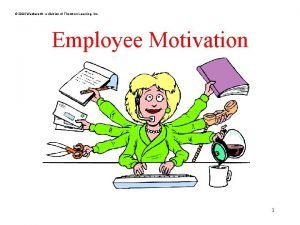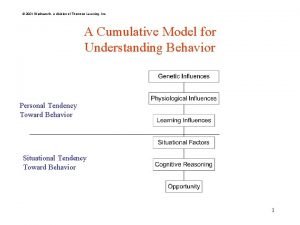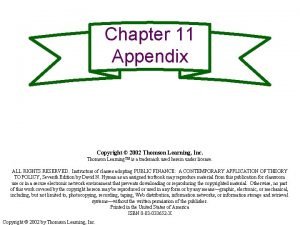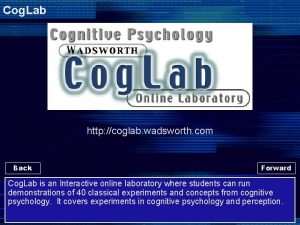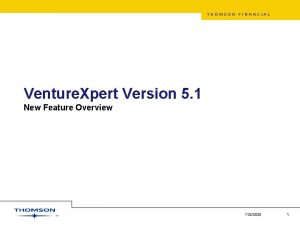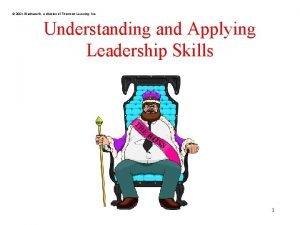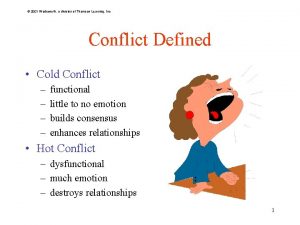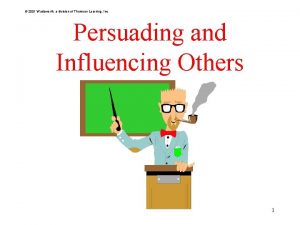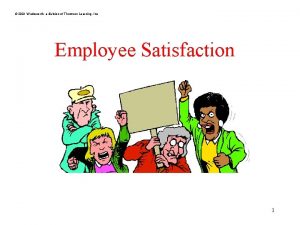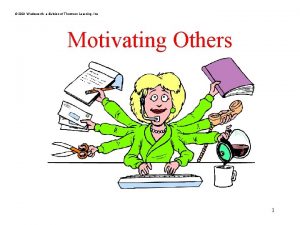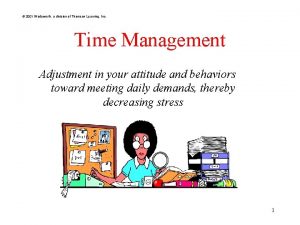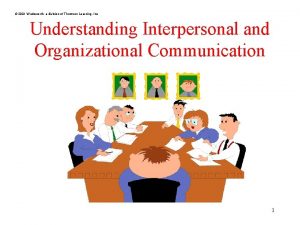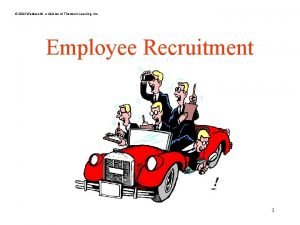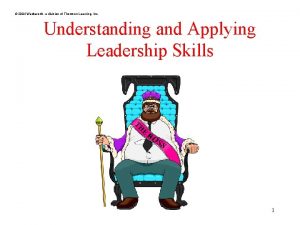2001 Wadsworth a division of Thomson Learning Inc






















- Slides: 22

© 2001 Wadsworth, a division of Thomson Learning, Inc Managing Change 1

© 2001 Wadsworth, a division of Thomson Learning, Inc Sacred-Cow Hunts • The Paper Cow • The Time Cow • The Meeting Cow • The Cash Cow 2

© 2001 Wadsworth, a division of Thomson Learning, Inc Stages of Change Carnall (1990) • • • Denial Defense Discarding Adaptation Internalization 3

© 2001 Wadsworth, a division of Thomson Learning, Inc Employee Acceptance of Change The Reason Behind the Change • Legitimate – financial reasons – external mandates – productivity improvement • Whim • Everybody else is doing it 4

© 2001 Wadsworth, a division of Thomson Learning, Inc Employee Acceptance of Change The Person Making the Change • Popularity • Degree of respect • History of successful change 5

© 2001 Wadsworth, a division of Thomson Learning, Inc Employee Acceptance of Change The Person Being Changed • • • Change agents Change analysts Receptive changers Reluctant changers Change resisters 6

© 2001 Wadsworth, a division of Thomson Learning, Inc Implementing Change • Creating an atmosphere for change • Communicating details – training is needed – two-way communication – honesty is essential • Time frame • Training needs 7

© 2001 Wadsworth, a division of Thomson Learning, Inc Organizational Culture Steps to Changing Culture • Assessing the new culture • Creating dissatisfaction with existing culture • Maintaining the new culture • Selecting new employees 8

© 2001 Wadsworth, a division of Thomson Learning, Inc Organizational Culture Assessing the New Culture • Needs assessment • Determining executive direction • Implementation considerations • Evaluation of the new culture • Creating dissatisfaction with the existing culture 9

© 2001 Wadsworth, a division of Thomson Learning, Inc Organizational Culture Maintaining the New Culture • Select new employees who are consistent with the new culture • Create a socialization process where new employees will learn about the new culture • Reward behaviors consistent with the new culture 10

© 2001 Wadsworth, a division of Thomson Learning, Inc Coping with Change • Speed up • Take the initiative • Spend energy on solutions 11

© 2001 Wadsworth, a division of Thomson Learning, Inc Empowerment 12

© 2001 Wadsworth, a division of Thomson Learning, Inc Factors in Making the Decision to Empower • Importance of decision • Probability of decision quality acceptance • Leader knowledge of • Subordinate trust and problem area motivation • Problem structure • Probability of subordinate conflict • Importance of decision acceptance 13

© 2001 Wadsworth, a division of Thomson Learning, Inc Decision-Making Strategies Using the Vroom-Yetton Model • • • Autocratic II Consultative II Group I 14

© 2001 Wadsworth, a division of Thomson Learning, Inc 15

© 2001 Wadsworth, a division of Thomson Learning, Inc Levels of Employee Input • Absolute – Sole responsibility for making decisions • Shared/Participative/Team – has an equal vote with management or other employees – Reaches decisions through group consensus or voting • Advisory – Makes recommendations – Suggests new ideas – Provides input • Ownership of Own Output – Employees are responsible for their own quality control – Control is only at the individual level • Following – Work is closely checked by others – Employee is closely supervised 16

© 2001 Wadsworth, a division of Thomson Learning, Inc Empowerment Charts 17

© 2001 Wadsworth, a division of Thomson Learning, Inc Consequences to Empowerment • Personal – Increased job satisfaction for most – Stress • decreased stress due to greater control • increased stress due to greater responsibility • Financial – Bonuses – Pay increases • Career – – Increased job security Promotions Increased marketability Increased chance of being terminated 18

© 2001 Wadsworth, a division of Thomson Learning, Inc Teams 19

© 2001 Wadsworth, a division of Thomson Learning, Inc What is a Team? Donnellon (1996) • • • Identification Interdependence Power differentiation Social distance Conflict management tactics • Negotiation process 20

© 2001 Wadsworth, a division of Thomson Learning, Inc How Teams Develop • • Forming Stage Storming Stage Norming Stage Performing Stage 21

© 2001 Wadsworth, a division of Thomson Learning, Inc Why Teams Don’t Always Work • • • The team is not a team Excessive meeting requirements Lack of empowerment Lack of skill Distrust to the team process Unclear objectives 22
 Wadsworth thomson learning
Wadsworth thomson learning Wadsworth/thomson learning
Wadsworth/thomson learning Thomson wadsworth
Thomson wadsworth Thomson learning inc
Thomson learning inc Thomson wadsworth
Thomson wadsworth Wadsworth
Wadsworth Thomson learning inc
Thomson learning inc Thomson learning inc
Thomson learning inc Wadsworth cengage learning
Wadsworth cengage learning Coglab.wadsworth
Coglab.wadsworth Henry wadsworth longfellow short biography
Henry wadsworth longfellow short biography Hn wadsworth
Hn wadsworth Excess b vitamins urine
Excess b vitamins urine Thomson delmar learning
Thomson delmar learning Trypsinogen is activated by
Trypsinogen is activated by Cuadro comparativo e-learning m-learning b-learning
Cuadro comparativo e-learning m-learning b-learning Long division and short division
Long division and short division Division of polynomials
Division of polynomials Method of hcf
Method of hcf Synthetic division with polynomials
Synthetic division with polynomials 2015 vista higher learning inc
2015 vista higher learning inc Tom thomson moonlight
Tom thomson moonlight Venture xpert
Venture xpert
